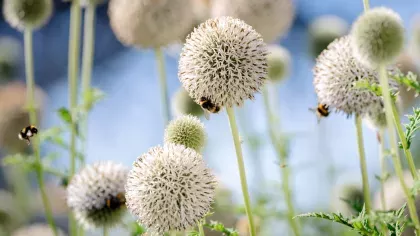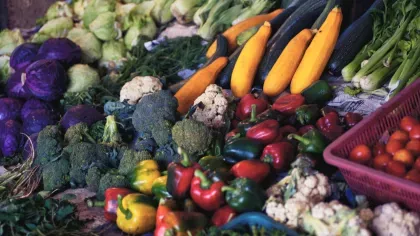Kew’s new Tropical Plant Identification Handbook
A new book written by botanists from Kew’s Herbarium aims to convey information about tropical plant families in an easy-to-use and accessible format.

Knowing the names of things is the first step in better understanding and conserving the planet's biodiversity. Plant identification is still well-served by the observation of morphological traits, but taxonomic accounts, such as Floras and monographs, are often written in technical language difficult for non-specialists to penetrate. Although DNA methods are being developed (e.g. CBOL, 2009), usable identification guides allow a broader audience to observe and gain an understanding of the biodiversity in the habitats that surround us, especially in species-rich areas such as the tropics.
Plant diversity is particularly rich in tropical habitats, such as the high tree species diversity in tropical rain forests, which are also important stores of fixed carbon. Kew has a long history of working in the tropics, with an associated tradition of training botanists to identify, describe and research this diversity. Recently, Kew has published The Kew Tropical Plant Families Identification Handbook (Utteridge & Bramley, 2014) to fill a need for an accessible guide to commonly encountered plant families that can be used anywhere in the tropics.
Sorting out a tropical problem
The Identification Handbook was developed from the Tropical Plant Identification Course that I have been running since 2004. The genesis of this course was the weekly family identification sessions, or family sorts, that are held in the Herbarium. Through expeditions and specimen exchange, Kew receives around 30,000 specimens each year, mainly from the tropics, that are sorted and named before incorporation into the collections. Generalist botanists, with differing regional expertise, run weekly identification sessions which are attended by staff and collaborators including students at various stages of their studies (my team runs the South-East Asia session, for example).
During these, it was clear that European students, with knowledge of a northern temperate flora, kept questioning many of the families: 'I don't know the Burseraceae/Simaroubaceae/Malpighiaceae [add tropical family of your choice],' was a common refrain. From this the Identification Course was developed, and from the course came the Identification Handbook. Fundamental to the course and handbook were the selection of groups and how should we teach them.
Which plant groups should we teach?
In the latest APG3 classification now followed at Kew (APG, 2009), there are over 400 families and a two-week course, or portable field guide, can't include every family. Geography, or distribution, is one of the most powerful characters for identification and we aimed to cover commonly encountered species-rich tropical families while excluding those families with restricted ranges or more temperate distributions. Families were selected from abundance lists generated by a very basic analysis of Gentry's plot data from tropical habitats across the globe (see Phillips & Miller 2002). These lists were given to experienced tropical botanists in Kew's Herbarium for comments and then used as the basis for the course and, eventually, the Handbook.
Because of the Handbook’s global approach, many groups that are restricted (endemic) to a particular area, are not included. There were also considerations of family delimitation, such as the Primulaceae and Ericaceae for example, which have been redefined and expanded in the APG3 classification. We selected only subfamily Myrsinoideae from the family Primulaceae (having to leave out the Maesoideae, my research group!), and focused on the Ericaceae in the traditional sense, leaving out the Epacrids. Why? Because these are taxa with more tropical members.
The process of identification
Teaching plant identification is best undertaken by outlining some basic information (spot or key characters) for an appropriate rank (families), followed by repetition of observation. Most early-career botanists have been impressed by the speed and accuracy of identifications by an experienced botanist, but are then quickly frustrated by the comment, 'because it looks like it', when they ask how the identification was reached. With time and experience, the 'gestalt' or 'jizz' of a plant is, more or less, instantly observed and processed against the botanist's mental database of characters and taxa.
‘Gestalt’ can be described as perceiving and understanding the entire form or shape, rather than the individual parts (i.e. the spot characters, in the case of plant identification). ‘Jizz’ is a term used by ornithologists and birders to convey a similar idea - the identification of an organism through observation of its entire form and/or behaviour, rather than any one particular attribute. To arrive at an understanding of a plant’s ‘gestalt’, several spot characters are best observed and used additionally. (It must be remembered, however, that they not synapomorphies as no one character is linked to any particular taxon.) Some examples of the most useful spot characters are leaf position, leaf type, leaf margins, presence/absence of stipules, and ovary position, but there are many more that can be used (see van Balgooy (1997) for a near complete list for South-East Asia).
The published handbook
Our challenge was to construct a book to give an idea of the general appearance or 'gestalt' of a plant family to a broad audience, and this is what we have tried to convey in the Identification Handbook. We have used a large amount of images, mostly photographs but also herbarium specimens (which are useful for scale) and line drawings. Text is arranged in different hierarchical sets of information starting with a few very basic spot characters, then more specific characters particularly useful for the majority of members of that family, and finally a longer and more detailed traditional description accounting for the entire range of variation in the family.
Unfortunately, (or fortunately, depending on your view) evolution has produced an extremely diverse and variable world with no plant family being entirely homogenous in its morphology (or any other attribute). We have tried to convey the fundamental characters used for tropical plant family identification, and we hope it will be useful.
References
Angiosperm Phylogeny Group. [APG] (2009). An update of the Angiosperm Phylogeny Group classification for the orders and families of flowering plants: APG III. Bot. J. Linnean Soc. 161: 105−121. Available online
CBOL Plant Working Group. (2009). A DNA barcode for land plants. Proceedings of the National Academy of Sciences 106: 12794–12797. doi:10.1073/pnas.0905845106 Available online
Phillips, O., & Miller, J. (2002) Global Patterns of Plant Diversity, Alwyn H. Gentry's Forest Transect Data Set (MSB 89).
Van Balgooy, M.M.J. (1997). Malesian seed plants. Volume 1 – Spot-characters. Leiden: Rijksherbarium/ Hortus Botanicus.
Utteridge, T.M.A. and Bramley, G.L.C., eds. (2014). The Kew Tropical Plant Families Identification Handbook. Kew: Royal Botanic Gardens, Kew.



